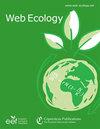地中海岛屿上的人口密度和拟甲虫的丰富度是共同变化的
IF 2.4
3区 环境科学与生态学
Q2 ECOLOGY
引用次数: 1
摘要
摘要预计人口增长将导致一些物种在当地灭绝。然而,即使在人口密集的地区,也可以发现意想不到的高生物多样性。虽然人口密度与生物多样性之间的正相关关系可以用中间干扰假说来解释,但另一种可能的解释可能来自于人类住区往往位于环境条件对许多其他动物物种特别有利的地点。为了验证这一假设,我们研究了意大利小岛上的土著拟甲虫种群密度与物种丰富度之间的关系。我们使用部分回归分析来评估岛屿面积(考虑物种-面积关系)、海拔(用作环境多样性的代理)和人类密度对物种丰富度的个体贡献。在控制面积和海拔后,拟黄蜂的多样性随人口密度的增加而增加。这可能表明,过去(和现在)更适合人类居住的岛屿,也可能更适合拟黄虫的生存。本文章由计算机程序翻译,如有差异,请以英文原文为准。
Human population density and tenebrionid richness covary in Mediterranean islands
Abstract. Human population growth is expected to drive several species to local extinction. Yet, an unexpected high biodiversity can be found even in densely populated areas. Although a positive correlation between human density and biodiversity can be explained by the intermediate disturbance hypothesis, an alternative possible explanation may come from the tendency of human settlements to be located in sites whose environmental conditions are particularly favourable also for many other animal species. To investigate this hypothesis, we studied the relationships between human population density and species richness of native tenebrionid beetles in small Italian islands. We used partial regression analysis to assess the individual contribution of island area (to account for the species–area relationship), elevation (used as a proxy of environmental diversity), and human density to species richness. We found that tenebrionid diversity increased with human population density even after controlling for area and elevation. This may suggest that islands that were (and are) more hospitable to humans are also those which can be more favourable for tenebrionids.
求助全文
通过发布文献求助,成功后即可免费获取论文全文。
去求助
来源期刊

Web Ecology
Agricultural and Biological Sciences-Ecology, Evolution, Behavior and Systematics
CiteScore
4.60
自引率
0.00%
发文量
6
审稿时长
17 weeks
期刊介绍:
Web Ecology (WE) is an open-access journal issued by the European Ecological Federation (EEF) representing the ecological societies within Europe and associated members. Its special value is to serve as a publication forum for national ecological societies that do not maintain their own society journal. Web Ecology publishes papers from all fields of ecology without any geographic restriction. It is a forum to communicate results of experimental, theoretical, and descriptive studies of general interest to an international audience. Original contributions, short communications, and reviews on ecological research on all kinds of organisms and ecosystems are welcome as well as papers that express emerging ideas and concepts with a sound scientific background.
 求助内容:
求助内容: 应助结果提醒方式:
应助结果提醒方式:


